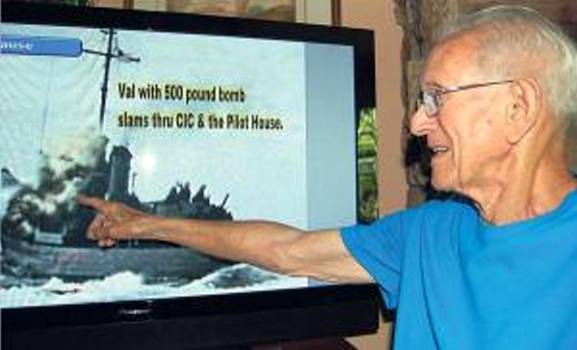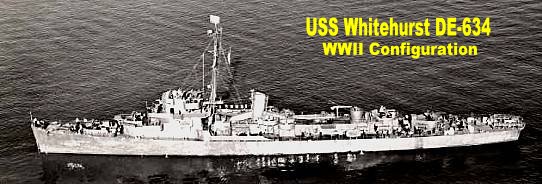|
St. Helenan remembers kamikaze hit
This article was published in the St Helena Star, Dec. 17, 2009 (St
Helena, CA)
By John Lindblom
STAFF WRITER
Thursday, December 17, 2009
From his battle station in the forward engine room of the USS
Whitehurst, a destroyer escort, Engineering Officer Sydney Calish felt
the horrific explosion and scrambled1
topside to see what had happened.

John Lindblom photo From a photo preserved on a DVD of the incident,
St. Helena’s Sydney Calish points out the Japanese kamikaze that hit
his ship, the USS Whitehurst, on April 12, 1945, on his TV screen.
Note the tail section of the plane at far left.6
One of his first observations was the helmsman, slumped but still
standing at the helm with both hands on the wheel, and his close
friend in the combat information center still stood with his arms
outstretched around two radarmen as if trying to protect them.
All were dead, as were 34 other of Calish’s shipmates. Twenty-three
more were injured — most of them seriously. Two of the 23 later died.
It was April 12, 1945 — a fateful day for Americans, as it was the day
President Franklin Delano Roosevelt died. And especially fateful for
the men of the Whitehurst, one of 21 U.S. ships hit by Japanese
kamikazes that day.
“I didn’t see the explosion. All I saw was the aftermath. Those who
were still there looked like figures in a wax museum, because a lot of
them were killed by the concussion,” Calish, a St. Helena resident,
recalled. “They were burned, too, but it was the concussion that
killed them, like being hit over the head, I guess.”
At the time, the Whitehurst was in a picket line in the waters off
Okinawa, patrolling for submarines and “Vals,” the Japanese code name2
for their kamikaze suicide planes.
For its part in the last big naval battle of World War II, Calish’s
ship had been ordered to join an attack force and had steamed in from
Ulithi naval base in the Caroline Islands.
“We were apprehensive in Okinawa,” he remembered, “because there had
been so many ships lost there. We were assigned to a radar picket
station where two ships had just been hit.”
But the Whitehurst crew knew its business. In the battle of Leyte Gulf
they had sunk a Japanese submarine (albeit unofficially because all
anyone ever saw was an oil slick and debris floating to the surface)
and were credited with downing four fighter planes.3
So when trouble from the air came in the form of four Vals, three of
them wound up at the bottom of the sea. The fourth, however, came
directly at the Whitehurst.
“It hit the port side, went all the way through the deckhouse and
wound up on the starboard side,” said Calish. “It was carrying a
500-pound armor-piercing bomb, but it didn’t hit the ship; it went on
[through the ship] and detonated in the air.”
Reflecting on the kamikazes and the pilots who flew them, he added,
“They (Japanese military) would provide only enough fuel that the
planes couldn’t get back to their home base. It was the same (logic)
as suicide bombers today. I don’t understand it, and I don’t think the
Western mind can grab hold of it.”
Calish was a member of the Whitehurst’s 210-man crew, and had an
almost familial feeling for the ship. He is a “plank owner,” and was
present at its commissioning ceremony in San Francisco in November
1943.
It was a rare fighting ship, one of only six destroyer escorts powered
by a turbo-electric engine in World War II.4
A newly minted officer, Calish was an Easterner who came west with his
family and graduated from UC Berkeley as a chemistry major in 1941.
After entering the Navy, he spent four months at the U.S. Naval
Academy in Annapolis, and learned most of what he knew about
engineering at Cornell University’s diesel school and a sub-chasing
center in Miami, Fla. He might have stayed in the Navy beyond the
three years he served, but his new bride saw what military families
endured while growing up in Long Beach and would have none of it.
Instead, Calish went to Chevron as a researcher.
The patched-up Whitehurst, meanwhile, sailed on, distinguishing itself
in the Korean War with three battle stars in less than a year. It also
played a role in the film “The Enemy Below” as a destroyer escort
under a fictional name, and survived a collision with a Norwegian
freighter that culminated in both vessels running aground.
At the ripe old age of 25 in 1969, the Whitehurst was finally
decommissioned. Two years later, the ship was torpedoed and sunk as a
target off Puget Sound.
Calish has a tattered ensign5
from the Whitehurst, and the ship’s destruction, he said, was a sad
moment for him and, doubtless, his surviving shipmates.
“I think it was,” he said. “You certainly form an attachment to the
people who served with you. I’ve been to a couple of reunions with
them. There aren’t many of us left.”
notes by Max
Crow, Webmaster USS Whitehurst Assn.
*corrections to the misleading statements identified by
numbers above.
1.
He did not leave his battle station to scramble topside. He went
topside to survey the damage after the ship was at her birth in Kerama
Retto.
2.
American Code name for the Aichi D3A, a Japanese Dive Bomber
3.
Prior to April 12, Whitehurst had downed only a twin engine bomber.
During the battle, her gunners shot down two Vals before the Suicide
strike and one after.
4.
Whitehurst was one of 6 Turbo-Electric DEs manufactured by
Bethlehem Steel. There were many other TE DEs in the war.
5.
Syd has a photo of Whitehurst’s tattered battle ensign. The actual
flag is in the possession of the Whitehurst veterans and families who
attend the reunions. It is now in a protective glass case which is
shown at every reunion.
6.
The picture displayed is from the Whitehurst WWII History DVD which I
produced from the war time log kept by George Baskin. There was
no battle photographer aboard Whitehurst or nearby when the suicide
bomber struck. The picture is a photo which has been
edited to illustrate the strike.
|

